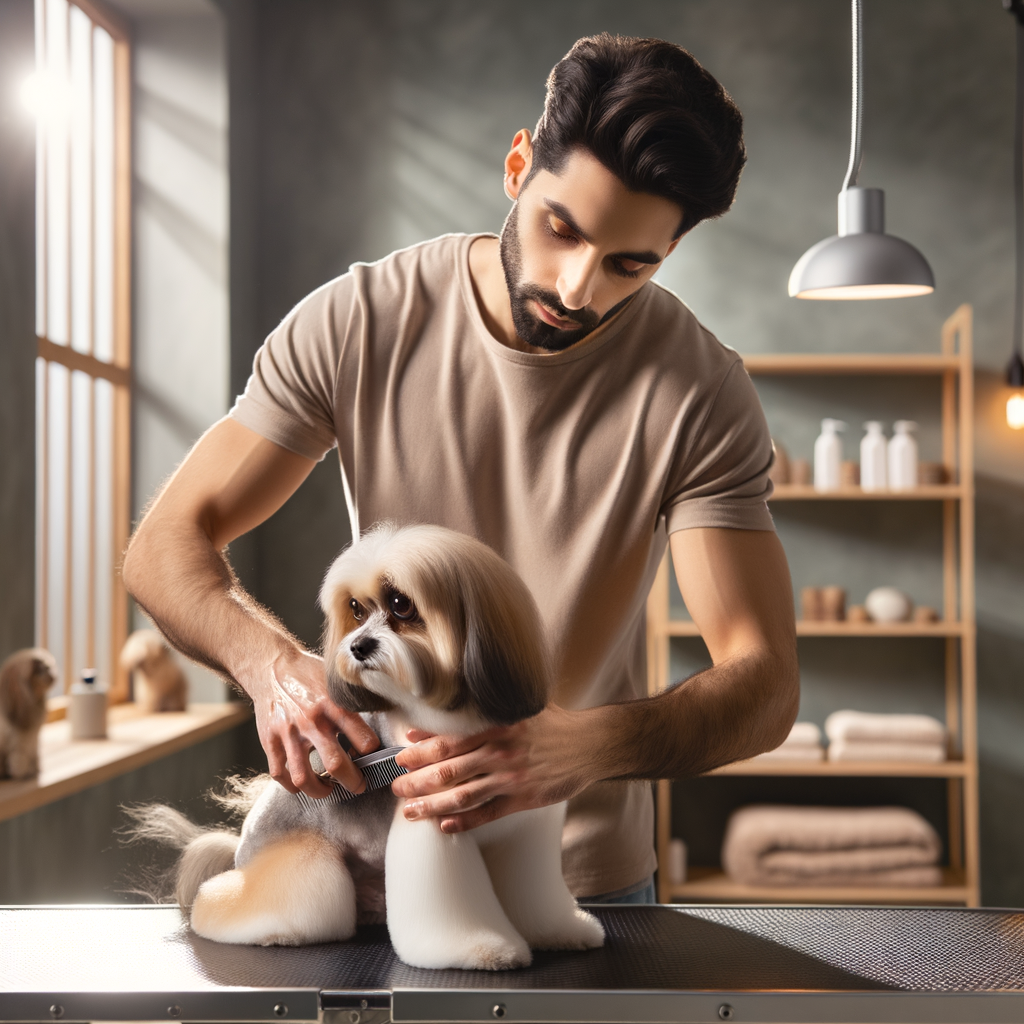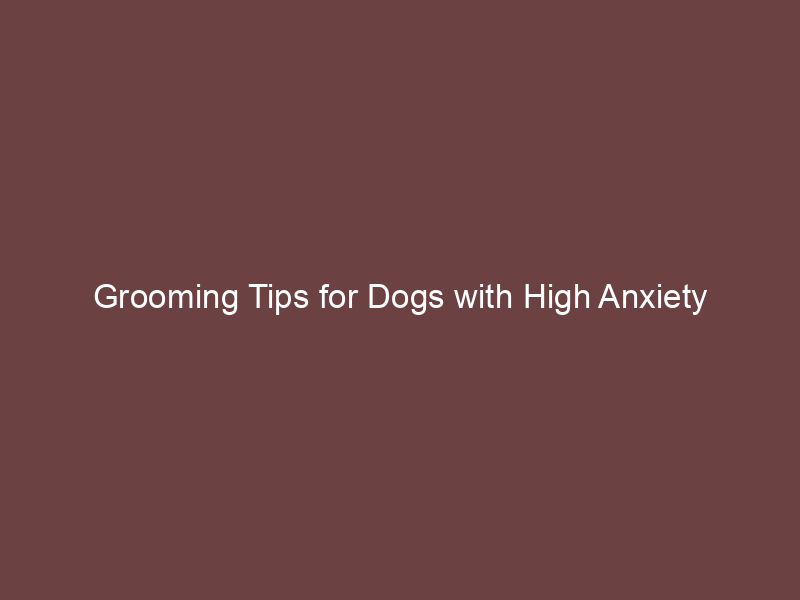
Introduction: Understanding Anxiety in Dogs
Anxiety in dogs is a feeling of fear or worry. It can be caused by many things, like loud noises, new places, or being away from their owners. Dogs show anxiety in different ways, and it can affect their behavior and health.
- Common signs of anxiety in dogs:
Dogs may show anxiety by barking a lot, shaking, hiding, or trying to escape. They might also chew on things, pace around, or have accidents inside the house. If you notice these signs, your dog might be anxious.
- How anxiety affects dog grooming:
Grooming can be stressful for anxious dogs. They might not like being touched or handled, making it hard to groom them. An anxious dog might try to run away, bark, or even bite. Understanding their anxiety can help make grooming easier and less stressful for them.
How to Groom an Anxious Dog: A Step-by-Step Guide
-
Preparing the Grooming Area
First, choose a quiet and comfortable place for grooming. Make sure the area is free from loud noises and distractions. Lay down a non-slip mat to help your dog feel secure.
Tip: Keep your dog’s favorite toys and treats nearby to create a positive environment.
-
Introducing Grooming Tools to Your Dog
Before starting, let your dog sniff and explore the grooming tools. This helps them get used to the items and reduces fear.
Tip: Use treats to reward your dog when they interact calmly with the tools.
-
Starting the Grooming Process
Begin with gentle brushing. Start from the back and move towards the head. Speak softly to your dog to keep them calm.
Tip: Take breaks if your dog seems stressed. Short sessions are better than long, stressful ones.
-
Handling Interruptions and Setbacks
If your dog gets anxious or upset, stop and give them a break. Offer a treat and some praise. Resume grooming once they are calm again.
Tip: Patience is key. It may take several sessions for your dog to feel comfortable with grooming.
Grooming Tips for Anxious Dogs
Pre-Grooming Tips
- Creating a calm environment:
Before grooming, make sure your dog feels safe. Choose a quiet room where your dog feels comfortable. Play soft music or use a white noise machine to block out any loud sounds that might scare your dog.
- Using anxiety relief products:
There are many products that can help calm your dog. Try using a calming spray or diffuser with natural ingredients like lavender or chamomile. You can also use anxiety wraps or vests that apply gentle pressure to help your dog feel secure.
- Practicing touch and handling exercises:
Get your dog used to being touched in areas that will be groomed. Start by gently touching their paws, ears, and tail. Reward them with treats and praise to create a positive association with handling.
During Grooming Tips
- Using calming techniques during grooming: It’s important to keep your dog calm during grooming. You can use soothing words and gentle petting. Playing soft music can also help. Some dogs respond well to calming sprays or diffusers with natural scents like lavender.
- Keeping a consistent routine: Dogs thrive on routine. Try to groom your dog at the same time and place each session. This helps them know what to expect and reduces anxiety. Consistency builds trust and makes the process smoother over time.
- Using positive reinforcement: Reward your dog with treats and praise during grooming. This makes the experience positive. Give a treat after each step, like brushing or nail trimming. Positive reinforcement encourages good behavior and helps reduce fear.
Post-Grooming Tips
- Providing rewards and praise: After grooming, it’s important to reward your dog. Give them their favorite treat or toy. Praise them with a happy voice and gentle petting. This helps them associate grooming with positive experiences.
- Monitoring your dog’s behavior post-grooming: Keep an eye on your dog after grooming. Look for signs of stress or discomfort. If they seem anxious, give them extra attention and comfort. This helps you understand how they feel about the grooming process.
- Adjusting future grooming sessions based on experience: Use what you learn from each grooming session to make the next one better. If your dog was calm during a certain part, try to repeat that. If they were anxious, think about what might help them feel better next time.
Stress-Free Dog Grooming: Products and Techniques
-
Anxiety Relief Products for Dogs
Many dogs feel anxious during grooming. To help them relax, you can use anxiety relief products. These include calming sprays, treats, and collars. Calming sprays often have natural ingredients like lavender. Treats can be given before grooming to help your dog feel at ease. Calming collars release soothing scents that help reduce stress.
-
Recommended Grooming Tools for Anxious Dogs
Using the right tools can make grooming less stressful for your dog. Look for brushes with soft bristles and grooming gloves. These tools are gentle on your dog’s skin. Clippers with quiet motors can also help, as loud noises can scare anxious dogs. Always choose tools that are comfortable for both you and your dog.
-
Professional Grooming Services for Anxious Dogs
If your dog is very anxious, consider professional grooming services. Many groomers specialize in handling anxious dogs. They use techniques to calm your pet and make grooming a positive experience. Some groomers also offer mobile services, which can be less stressful for your dog since they stay in a familiar environment.
Grooming a Nervous Dog: Case Studies
-
Case Study 1: Overcoming Grooming Anxiety with a Rescue Dog
Meet Bella, a rescue dog who was very scared of grooming. Bella’s owner noticed she would shake and hide whenever it was time for a bath or brush. To help Bella, her owner started with short grooming sessions. They used treats and gentle words to make Bella feel safe.
After a few weeks, Bella began to relax. Now, Bella enjoys her grooming time and even looks forward to it! This shows that patience and kindness can help a nervous dog feel better about grooming.
-
Case Study 2: Implementing a Grooming Routine for a Nervous Puppy
Charlie, a young puppy, was very nervous about grooming. His owners decided to create a routine to help him. They started by brushing Charlie every day for just a few minutes. They made sure to do this at the same time each day.
They also used a special brush that was gentle on Charlie’s fur. Over time, Charlie got used to the routine and became less scared. Now, Charlie is calm and happy during grooming sessions. This case shows how a consistent routine can help a nervous puppy.
-
Case Study 3: Using Professional Services for a Dog with Severe Grooming Anxiety
Max had severe grooming anxiety. His owners tried everything but nothing seemed to work. They decided to seek help from a professional groomer who specializes in anxious dogs. The groomer used special techniques and tools to help Max feel comfortable.
After a few visits, Max’s anxiety started to decrease. He began to trust the groomer and even enjoyed the sessions. This case shows that professional help can make a big difference for dogs with severe grooming anxiety.
Conclusion: The Importance of Patience and Consistency
Grooming an anxious dog requires a calm and steady hand. Dogs pick up on our emotions, so staying relaxed helps them feel safe. Consistency in your grooming routine builds trust and makes the process smoother over time.
- Encouraging patience and understanding with anxious dogs:
Remember, anxious dogs need extra time and care. Patience is key. If your dog is nervous, take breaks and offer plenty of praise and treats. This helps them associate grooming with positive experiences.
- Final thoughts on the benefits of successful grooming for dogs with high anxiety:
Successfully grooming an anxious dog can improve their overall well-being. Regular grooming keeps their coat healthy, reduces the risk of infections, and strengthens the bond between you and your pet. With patience and consistency, you can turn grooming into a positive experience for your anxious dog.






